1211-B. McChord AFB, Seattle, Wash., 2 October 1959, 0020-0320 LST. Weather: clear, fog moved in at 0150 LST
after initial sighting, wind from 100 at 10 knots (approx.). Radar at McChord AFB picked up a total of five or more
unidentified tracks between 0020 to 0320 LST. These targets appeared to be at elevation angles of about l0° -20° and
azimuths of l70° -l90°. The range would change from 4,000 yd. to 8,000 yd., and the flight patterns were described as
"erratic;" returns would occasionally appear in pairs. The radar blips were described as "weak
." Data on the
vertical beam width and the antenna pattern characteristics of the radar are lacking.
Visual observers were apparently told to go outside and look for an UFO at about 10° elevation and 190° azimuth. They
found one - "round," "the size of a quarter
" (distance not specified), "white and blue flickering light
,"
a rather good description of a scintillating star. There was a second magnitude star at precisely the correct azimuth
(190°) at the time, although the elevation angle would have been only about 1° or so. A sharp temperature inversion,
with mist trapped below it, could have easily produced the effect of larger size as well as increased the apparent
elevation angle by about 1°. Even trained observers consistently over-estimate the elevation angle of objects near the
horizon., as in the "moon illusion" (the apparent increase in size of the rising moon).
When "last seen
," at about 0150 LST, the object was reported to be about 20° elevation and 170° azimuth. At
that time another bright star (0.7 magnitude fainter than the first one) was located at about 172° azimuth and about
10° elevation, values commensurate with the apparent visual position (again, assuming over-estimate of elevation
angle). Near the horizon these were the only two stars of third magnitude or greater in that part of the sky at that
time.
The description of the radar targets, weak, erratic blips, together with the reported formation of a low-level fog (that hindered visual observations after 0150 LST), suggests the presence of a shallow temperature inversion-humidity trap that was producing AP echoes on the radar set. The UFO report states that temperature inversions were "prevalent" in the area.
In summary, this UFO incident appears to have been caused by radar AP echoes and associated visual star sightings, both observed at small angles through a surface temperature inversion-humidity trap layer.
103-B. Gulf of Mexico, off Louisiana coast (28° N 92° W), 6 December 1952, 0525-0535 LST (1125 GMT). Weather: clear, dry, light winds, visibility excellent, full moon. The radio refractivity profile for Burwood, La., about 175 mi. NE of location of sighting, for 0900 LST is shown in Fig. 12; a very strong super-refractive layer is shown on this profile over a height interval extending from the surface to 456 m. (1,500 ft.). A sharp temperature inversion existed at the top of this layer. As an aircraft was returning to Galveston, Tex. at 20,000 ft. burn-off flares from oil refineries became visible. The radar was activated on 100 mi. range to check for the Louisiana coastline. The range to the nearest point on the coastline was about 89 mi. and assuming standard propagation conditions, the range to the radar horizon should have been on the order of 140 mi. Surprisingly, the coastline could not be seen on the radarscope. Instead a number of unusual echoes were observed. Initially there were four moving an a course of 120° true azimuth. These blips moved at apparent speeds of over 5,000 mph., coming within 15-20 mi. of the aircraft's position. Eventually they disappeared from the scope. The radar set was calibrated, but more blips appeared still moving SE across the scope.
Visual observations consisted of one or two blue-white flashes, one of which, as viewed from the waist blister,
appeared to pass under a wing of the aircraft. All of these may have been above the horizon, since the wingtip would
appear well above the horizon as viewed from this position. The observers stated that the flashes "did not alter
course whatsoever
." These visual sightings were probably Geminid meteors; the wing operations officer stated: "Visual
sightings are indecisive and of little confirmatory value
."
One of the radar witnesses stated: "One object came directly towards the center of the scope and then
disappeared
." After 10 min. of radar observation, a group of the blips merged into a half-inch curved arc about 30
mi. from the aircraft at 320° relative azimuth and proceeded across and off the scope at a computed speed of over
9,000 mph. After this, no more unidentified returns were noted on the radar.
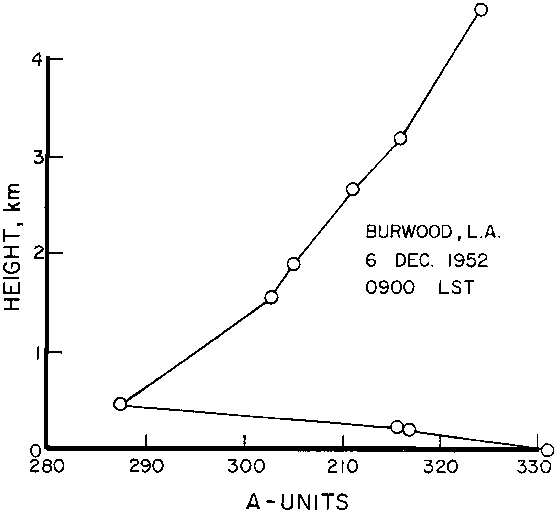
The radar returns obtained in this incident were probably caused by the deep super-refractive layer near the surface shown in Fig. 12.
That this layer was present at the time and in the area is indicated by the failure of the aircraft radar to detect the Louisiana coastline even though burn-off flares on the shore were visible to the unaided eye. The layer was probably slightly stronger at the time of the incident, thus constituting a thick radio duct. A transmitter located above a radio duct and emitting a high enough frequency to be affected, as the radar undoubtedly was, does not excite propagation within the duct. This implies that the coastline below the duct would not be visible to the radar located above the duct.
The strange moving targets seen on the radar were probably caused by imperfections in the atmospheric layer forming the radio duct, allowing the radio energy to enter the ducting layer at various points. This would create sporadic ground returns. The returns may have been caused by a series of gravity waves running along the ducting layer in a SE direction; this is a phenomenon which is at present only poorly understood. In any event, spurious radar images have often been noted under propagation conditions of this sort, often moving at apparent speeds of from tens to thousands of miles per hour.
In summary, it seems most likely that the cause of this sighting can be assigned to radar AP, for which there is meteorological evidence, and meteors.
7-C. White Sands Missile Range, N. M., 2 March 1967, 1025-1132 LST. Weather: apparently clear (few
meteorological data are available). A single witness at the summit of highway 70 over the Sacramento Mountains (Apache
Summit, 9,000 ft. elevation) reported seeing "silvery specks
" passing overhead from north to south. The witness
called Holloman AFB, and range surveillance radar was requested to look for the objects. Two aircraft were scrambled,
but neither reported a sighting, although they searched the area where the UFOs were reported.
Two radars were in operation. Both tracked a number of targets, most of which were stationary and so intermittent in nature as to prevent lock-on (see Case 16). Significantly, none of the radar targets was behaving in the manner described by this witness (i.e., moving steadily south at high altitude). Therefore, this incident is considered to be primarily a radar contact.
The probable nature of each of the three types of radar contact made is examined below.
- The stationary, intermittent targets. Most of these can be identified with terrain features, peaks or ridges, that would normally be just below the radar's line of sight. If the atmospheric conditions were such as to render these points just barely detectable by the radars, they would probably appear as intermittent, stationary targets of the type described.
-
The object at 25,000 ft. that "
drifted east three or four miles in about 10 minutes
" was apparently moving with the prevailing upper winds from the west; it may have been a weather balloon, or some similar device. - The circular track executed by the Holloman radar was interpreted by the radar engineers on the base as being a noise track. This seems quite likely, despite some apparent discrepancies noted in the report. If this track represented a real target, it is strange that the Elephant Mountain radar never picked it up, in spite of the fact that the apparent track passed within about 6.5 mi. of the second radar's location.
190-N. Detroit, Mich., March 1953, about 1000 to 1100 LST (exact date and time unknown). Weather: "perfectly
clear
." A USAF pilot and a radar operator, flying in an F-94B fighter on a practice training mission, were
directed by GCI radar at Selfridge AFB to intercept some unknown targets which appeared to be over downtown Detroit.
The pilot and radar operator looked in that direction and saw "tiny specks in the sky, which appeared to look like
a ragged formation of aircraft."
The aircraft at this time was about 30 mi. NW of downtown Detroit, and the targets "appeared to be over the city's
central section
." The pilot turned the aircraft to an intercept course. During this time, perhaps "three or
four minutes
," the objects were visible to the pilot as "a ragged formation traveling slowly in a westward
direction
;" the objects appeared to be "a little lower than our aircraft
." The pilot started his intercept
run under full military power, without afterburner, at approximately 500 mph.
The pilot recalls thinking several times that details of the unknowns, like wings, tails, etc. should have "popped out" as they approached, so that identification could be made, but they did not. The ground radar had both the F-94B and the unknowns "painted as good, strong targets." The unknowns could still not be identified, but "seemed to get a little larger all the time."
The F-94B's radar operator began to get returns and "thought he was picking up the targets
." The pilot looked
at his instruments to see if he could "inch out a little more speed without going into after-burner
," and when
he looked up again "every last one" of the objects was gone. The pilot asked GCI where the UFOs were, and was told
they were still there, "loud and clear." They continued to fly headings given by GCI right into the center of the
targets, flying and turning in "every direction," but there was nothing in sight. The pilot states: "Gradually the
targets disappeared from ground radar after we had been amongst them for 3 ou 4 mn
." The F-94B then returned to
base.
Since the exact date of this sighting is unknown, no applicable meteorological data are available. Any explanation of
this incident must therefore remain speculative in nature. If the UFOs are considered to have been material objects,
then they would have had to have shifted position some tens of miles in the 2 à 4
s while the pilot was looking
down at his instruments. This does not explain why they continued to appear on the ground radar. The only admissable
hypothesis would seem to be that they became invisible as the fighter approached, but this does not account for the
fact that they could not be picked up on airborne radar while the aircraft was searching the area.
There is one hypothesis that seems to fit all of the observed facts: that the "ragged formation
" was actually
an inferior mirage (see Section VI, Chapter 4). The angular conditions are satisfied: the objects appeared "slightly
below the level of the aircraft
," and reflections of the sky above the horizon would seem dark when seen projected
against the hazy sky directly over the city. A layer of heated air, trapped temporarily below a cooler layer by a
stable vertical wind shear, could produce a wavy interface that would reflect the sky in a few spots. This phenomenon
is quite similar to the familiar road mirage. Like, a road mirage it suddenly disappears when one gets too close and
the viewing angle becomes either too large or too small.
If the warm air below, the source of which would presumably have been the downtown area of Detroit, were also considerably moister than the cooler air above as is quite probable, then the radio refractive index would decrease quite suddenly across the inter-face. This would tend to produce anomalous propagation effects, including false echoes, on radar, and would explain why ground radar could continue tracking the unknowns when the pilot and airborne radar operator could no longer see them. The airborne radar, being immersed in the layer would probably not receive AP echoes of any duration other than, perhaps, occasional random blips.
After the aircraft had thoroughly mixed the opposing air currents by flying repeatedly through the interface as it searched for the targets, the ground radar returns would gradually fade away. This corresponds to what was actually observed.
In summary, without the data to make a more definitive evaluation of this case, the most likely cause seems to be a combined radio-optical mirage as described above. If so, this is another example of a natural phenomenon so rare that it is seldom observed: for a 0.25° critical mirage angle, the temperature contrast required is on the order of 10° or 15°C in the space of about 1 cm.
Washington, D.C. (see Appendix L) 19-20 and 26-27 July 1952.
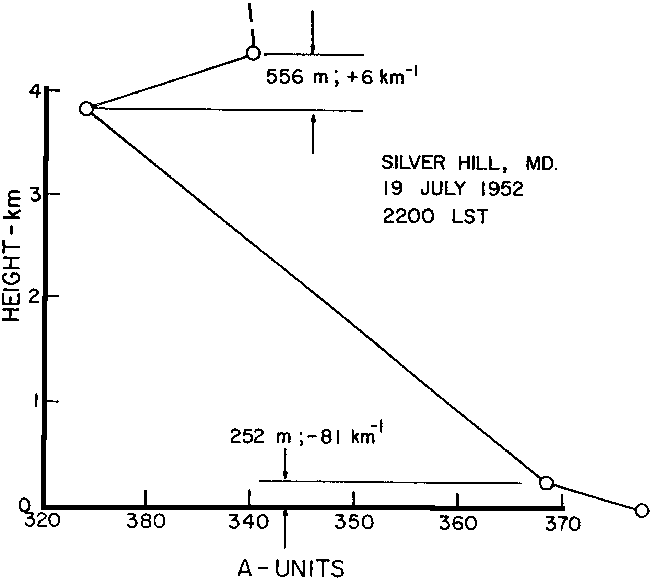
Weather: mostly clear, a few scattered clouds, visibility 10 to 15 mi., temperature 76° to 87°F, dewpoint 61° to 72°F, surface winds from SE, light, near surface, from 300° to 320° aloft, light. Radio refractive index profiles are shown in Figs. 13, 14, and 15, in Md., at an elevation of 88 m. (289 ft.) above sea level. There are a tremendous number of reports of UFOs observed on these two nights. In most instances visual observers, especially in scrambled aircraft, were unable to see targets indicated on ground radar, or to make airborne radar contact. Ground radar observers were often able to find a return in the general area of reported visual contacts, especially in the case of ground visual reports where only an azimuth was given. A few excerpts from typical reports during these incidents are given below:
Control tower operator, Andrews AFB, 0100 to 0500 EST, 20 July 1952:
An airman became excited during the conversation and suddenly yelled "there goes one." I saw a falling star go from overhead a short distance south and burn out. About two minutes later (the airman) said, "There's another one;
did you see the orange glow to the south?" I said I thought I saw it, but he pointed south and I had been looking south-west. I went up on the roof---and watched the sky in all directions. In the meantime Washington Center was reporting targets on their radar screen over Andrews. Andrews Approach Control observed nothing.
[The airman] was in the tower talking on the phone and interphones. He was watching a star and telling various people that it was moving up and descending rapidly and going from left to right, and [another airman] and I, listening to him from the roof, believed we saw it move too. Such is the power of suggestion.
This star was to the east slightly to the left of and above the rotating beacon. [The airman] reported the star as two miles east of Andrews and at an altitude of 2,000 ft.
A short time later, approximately 0200 hours, I saw a falling star go from overhead to the north. A few minutes later another went in the same direction. They faded and went out within two seconds. The sky was full of stars, the Milky Way was bright, and I was surprised that we did not see more falling stars.
All night Washington Center was reporting objects near or over Andrews, but Andrews Approach Control could see nothing, however they could see the various aircraft reported so their [radar] screen was apparently in good operation.
At 0500 hours Washington Center called me and reported an unknown object five miles southeast of Andrews field. I looked and saw nothing, That was the last report I heard.
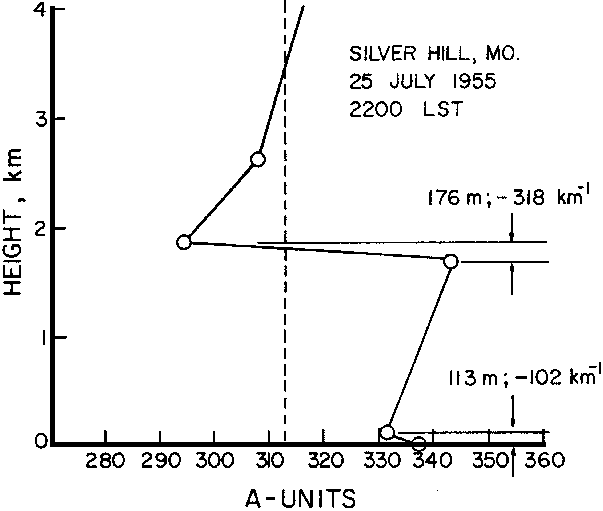
A USAF Captain at Andrews AFB radar center:
At about 0200 EST Washington Center advised that their radar had a target five miles east of Andrews Field. Andrews tower reported seeing a light, which changed color, and said it was moving towards Andrews. I went outside as no target appeared on Andrews radar and saw a light as reported by the tower. It was between 10° and 15° above the horizon and seemed to change color, from red to orange to green to red again. It seemed to float, but at times to dip suddenly and appear to lose altitude. It did not have the appearance of any star I have ever observed before. At the time of observation there was a star due east of my position. Its brilliance was approximately the same as the object and it appeared at about the same angle, 10° to 157deg; above the horizon. The star did not change color or have any apparent movement. I estimated the object to be between three and four miles east of Andrews Field at approximately 2,000 ft. During the next hour very few reports were received from Washington Center. [According to Washington Center's account, however, the 0200 EST object was seen on radar to pass over Andrews and fade out to the southwest of Andrews -- G. D. T.] At approximately 0300 EST I again went outside to look at the object. At this time both the star and the object had increased elevation by about 10°. [The azimuth would have also increased about 10°, so that the observed change was apparently equal to the sidereal rate, 15° of right ascension per hour -- G. D. T.] The object had ceased to have any apparent movement, but still appeared to be changing color. On the basis of the second observation, I believe the unidentified object was a star.
The account of the airman referred to by the Andrews AFB control tower operator:
Airman [X] called the tower and reported he had seen objects in the air around Andrews; while we were discussing them he advised me to look to the south immediately. When I looked there was an object which appeared to be like an orange ball of fire, trailing a tail; it appeared to be about two miles south and one half mile east of the Andrews Range [station]. It was very bright and definite, and unlike anything I had ever seen before. The position of something like that is hard to determine accurately. It made kind of a circular movement, and then took off at an unbelievable speed; it disappeared in a split second. This took place around 0005 EST. Seconds later, I saw another one, same description as the one before; it made an arc-like pattern and then disappeared. I only saw each object for about a second. The second one was over the Andrews Range; the direction appeared to be southerly.
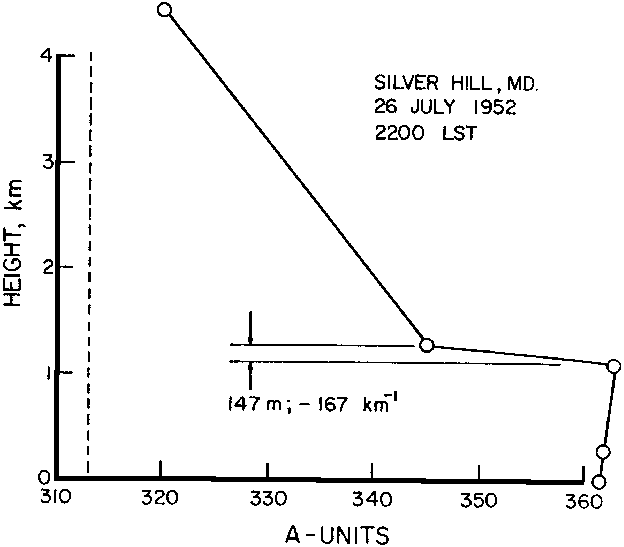
The account of a staff sergeant at Andrews AFB follows. He was apparently describing the same object that the radar center Captain had observed.
Later on we spotted what seemed to be a star north-east of the field, which was in the general direction of Baltimore. It was about tree top level from where I was watching. It was very bright but not the same color (as some apparent meteors). This was a bluish silver. It was very erratic in motion; it moved up from side to side. Its motion was very fast. Three times I saw a red object leave the silver object at a high rate of speed and move east out of sight. At this time I had to service a C-47 and lost sight of it for the night. The time was about 0330.
The visual sightings in these incidents seem to be either meteors, apparently quite numerous at the time, or stars, but a few descriptions are not adequate to make an identification and hence may represent unknowns.
The radar tracks reported, at various times, from Washington National Airport, Andrews AFB, and Bolling AFB are generally not correlated with each other, with airborne radar/visual observations, or with ground visual reports, except in a very general way, e.g., a star sighted on the azimuth supplied by the radar track.
An investigation of the radar tracks reported by Borden and Vickers (1953) is very informative. The authors observed, on the night of 13-14 August 1952, radar tracks very similar to those described in the 19-20 and 25-27 July incidents. The targets appeared to move with the upper winds at various levels at twice the observed wind speed, suggesting that they were ground returns seen by partial reflections from moving atmospheric layers of relatively small horizontal extent (i.e., patches of local intensification of a general super-refractive stratum). Borden and Vickers state:
The almost simultaneous appearance of the first moving targets with the [stationary] ground returns, [the latter] signifying the beginning of the temperature inversion, suggested that the target display was perhaps caused by some effects existing in or near the inversion layers.
The authors also relate similar target patterns observed during testing of a new radar at Indianapolis in November, 1952. They state:
Targets were larger, stronger, and more numerous than those observed by the writers during the Washington observations. At times the clutter made it difficult to keep track of actual aircraft targets on the scope.
In all major respects this report (Borden, 1953) is an excellent analysis of the probable radar situation during the July 1952, Washington sightings.
The atmospheric conditions in existence at the times of these UFO incidents, as shown in Figs. 13, 14, and 15, are rather peculiar. Refractivity profile for 19 July 2200 LST shows a surface inversion of l.7° C (3.1° F) but the resulting refractivity gradient is only -81 km-1, about twice the "standard" value. There is a rather unusual subrefractive layer at 3833 to 4389 m. produced by overlying moist air. Relative humidity drops from 84% at surface to 20% at base of this layer, then climbs to 70% at top of the layer. A number of significant levels are missing from this profile, which is common in 1952 Silver Hill profiles, but even so it is indicative of unusual atmospheric conditions. The radar sightings were made between 2340 LST and 0540 LST (July 20), and the atmospheric stratification was no doubt more strongly developed by that time. In addition, Silver Hill is at an elevation of 88 m. (289 ft.) above MSL, whereas Washington National Airport is at an elevation of only 13 m. (43 ft.). The intervening 75 m. is precisely that part of the atmosphere in which some of the most spectacular super-refractive and ducting layers would be expected to develop. Indeed, records for 1945-1950, during which radiosonde upper-air soundings were launched from Washington National Airport, reveal a much stronger tendency for the formation of anomalous propagation conditions than the Silver Hill data.
The profiles for 25 July and 26 July, 2200 LST are more complete than the 19 July profile, although some significant levels were noted as missing from the 26 July profile. Otherwise, the foregoing comments apply to these profiles as well. The 25 July profile shows a super- refractive surface layer and a strong elevated duct; there is a 4.6°C (8.3° F) temperature inversion through the elevated duct. It is perhaps significant that unidentified radar targets began appearing at 2030 LST on 25 July. The 26 July profile has a l.2° C (2.2°F) surface inversion without a humidity lapse sufficient to cause super-refraction; however, a 0.9° C inversion between 1115 and 1275 m. is associated with a sharp humidity drop and a resulting elevated duct with a gradient of -167 km-1. This elevated layer is quite strong enough to produce AP effects on radar. Unidentified radar targets began appearing at 2050 LST on 26 July and continued until after midnight.
In summary, the following statements appear to be correct:
- The atmospheric conditions during the period 19-20 and 25-27 July, 1952, in the Washington, D. C., area, were conducive to anomalous propagation of radar signals;
- The unidentified radar returns obtained during these incidents were most likely the result of anomalous propagation (AP);
- The visual objects were, with one or two possible exceptions, identifiable as most probably meteors and scintillating stars.
Wichita. Kans. area, 2 August 1965, "early morning hours" up to "shortly after 0600" LST.
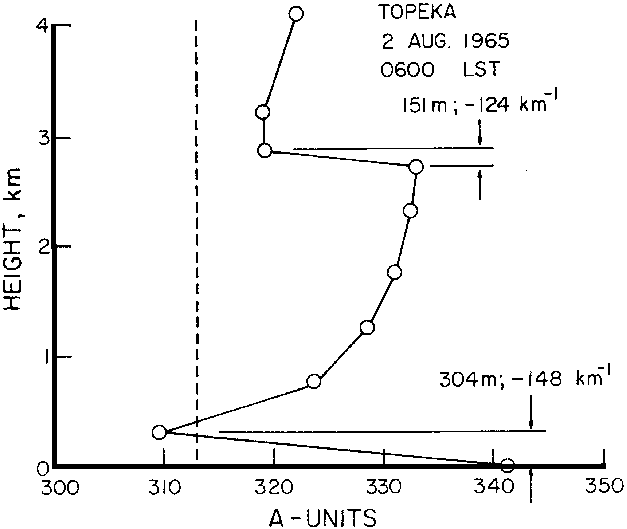
Weather: clear, temperature 61° F to 70°F, wind at surface: light from WSW. This is classed as primarily radar since the bulk of the reports were from radar and the first visual object was never described. The refractivity profiles for Topeka, Kans. and Oklahoma City, Okla are shown in Figs. 16 and 17.
During the early morning hours of 2 August 1965, the Wichita Weather Bureau Airport Station was contacted by the dispatcher of the Sedgwick County Sheriffs Department with regard to an object sighted in the sky near Wellington, Kans. (25 mi. south of Wichita). The radar operator, Mr. John S. Shockley observed what appeared to be an aircraft target near Udall, Kans., 15 mi. northeast of Wellington. This target moved northward at 40 to 50 mph.
During the next hour and a half several of these targets were observed on the radar scope over central Kansas moving slowly northward occasionally remaining stationary, or moving about erratically.
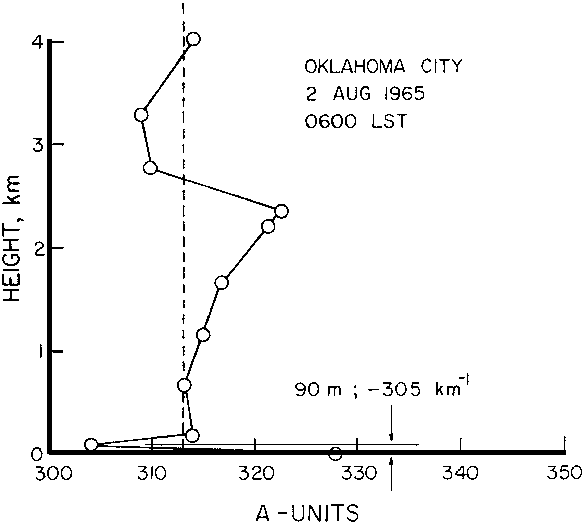
Mr. Shockley checked with the Wichita Radar Approach Control, however they were not able to observe a target simultaneously, with the exception of one aircraft south of McConnell Air Force Base near Wichita.
Later, a target was observed about seven miles NNW of Wellington, Kans., moving slowly southward. The Wellington Police Department was contacted and two officers went three miles west of the city, to see if they could observe anything. The target passed about one mile west of the city as observed on radar. The officers did not observe it until it was southwest of the city. They described it as a greenish-blue light that moved slowly away from them.
The dispatcher called again, with a report that two officers at Caldwell, Kans. (35 mi. south of Wichita) had sighted an object near the ground east of the city. A target was observed about two miles northwest of the city that moved northward and disappeared.
At daybreak, the dispatcher reported that the Wellington officers had an object in sight east of the city. Radar indicated a target in that area moving southward about 45 mph. Four or five people stopped their cars and watched the object with the officers. It was described as an egg-shaped object about the size of three automobiles, made of a highly polished silver metal.
Shortly after 0600C, a target was observed five miles north of Wellington moving southward. The target moved directly over the city to a point ten miles south of the city where it disappeared. The officers in Wellington were contacted but were able to observe absolutely nothing in the sky overhead during that time.
The radar was operated in long pulse, at 50 mi. range, with STC off. The targets were coherent and appeared from six to nine thousand feet on the RHI scope during the early morning and about four or five thousand feet later in the morning.
The descriptions of most of the visual objects in this sighting are too cursory to allow for any reasonable conjecture
as to the real nature of the objects. One of the objects, described as "a greenish-blue light that moved slowly
away
," may have been a star.
In most instances the radar targets did not seem directly related to the visual UFOs. This is characteristic of radar anomalous propagation returns.
The refractivity profiles both show highly refractive surface layers, with a 6.7° C (12.1° F) surface inversion at Topeka and a 9.7°C (17.5°F) surface inversion at Oklahoma City. In addition, the Topeka profile shows a strong elevated layer at 2720 m. with a 0.6°C inversion. The temperature inversion at Oklahoma City produced a surface layer having an optical refractivity gradient (at 5570Å of -101 km-1; this layer would extend the theoretical optical horizon for the eye of an observer 2 m. above the surface of a smooth earth from the normal value of 5.6 km. (9 mi.) to 8.5 km. (about 14 mi.). Such inversions can produce many strange effects, including the visibility of objects normally well below the horizon.
In summary, since the atmospheric conditions were conducive to anomalous radar propagation, and the radar targets displayed AP-like characteristics, this incident may probably be classified as consisting of radar false targets, with associated optical sightings that may have been enhanced by a strong temperature inversion at the surface.